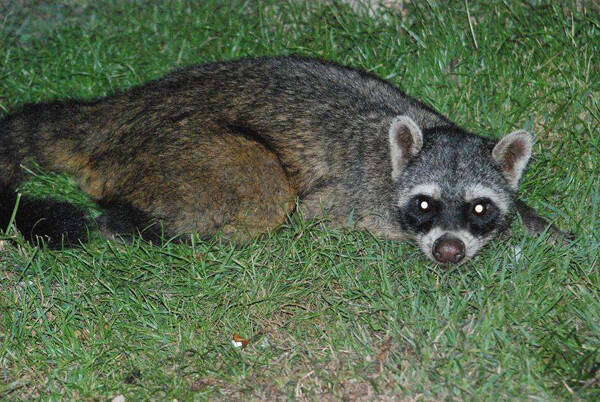Procyon cancrivorus
IUCN
LCBasic Information
Scientific classification
- name:Procyon cancrivorus
- Scientific Name:Procyon cancrivorus,Crab-eating Raccoon
- Outline:Carnivora
- Family:Procyonidae Procyoninae Procyon
Vital signs
- length:54-76cm
- Weight:3.1-7.7kg
- lifetime:About 12 years
Feature
Color blind, but has excellent night vision
Distribution and Habitat
Geographical range: From Costa Rica through Uruguay to eastern and western Paraguay and into northern Argentina. Its range overlaps with the North American raccoon in Costa Rica and Panama.
Specific countries: Argentina, Bolivia, Brazil, Colombia, Costa Rica, Ecuador, French Guiana, Guyana, Panama, Paraguay, Peru, Suriname, Trinidad and Tobago, Uruguay, Venezuela (Bolivarian Republic of).
The Crab-Eating Raccoon inhabits a variety of habitat types, usually forests, shrubs, wooded grasslands, swamps and mixed land bodies of water and coasts. Lives in dry, early Paraguayan Chaco small tree forests, where water sources are mostly artificial. Can use pastures and plantations, rarely seen in urban areas. Crab-Eating Raccoons will adapt as long as there is water, food and a place to hide.
Appearance
Body length is 54-76 cm. Tail length is 25-38 cm. Weight is 3.1-7.7 kg. The tail is about 50% of the body length. Males tend to be larger than females. The Crab-Eating Coon is a slender-bodied raccoon with short, dense fur. The neck fur slopes toward the head. The black eye patch fades behind the eye, unlike the raccoon, which has an eye patch that extends almost to the ear. The fur is gray-brown with light yellow, tan, and red hues, especially in the transition to the lighter ventral surface. The legs and feet are dark gray-brown, in stark contrast to the raccoon, whose feet are always light.
Details
Crab-eating raccoon (scientific name: Procyon cancrivorus) is also known as Crab-eating Raccoon. It is a Procyonidae, Procyon genus animal with 4 subspecies.

Crab-eating raccoon is smaller than the North American raccoon (Procyon lotor), which helps to distinguish the two species. Males of the North American raccoon weigh 7-8.3 kg, while females weigh 5.1-7.1 kg. Crab-eating raccoons appear thinner than North American raccoons due to less fur.
Crab-eating raccoons have well-developed senses and are very intelligent. They are nocturnal and color-blind, but have excellent night vision. Their sense of touch is different from other carnivores, with a well-developed sense of touch, especially in the nose and forehead (hands), and they use their hands as tools. They use their hands to handle and clean food before putting it in their mouths. They are dexterous and can manipulate small prey. Crab-eating raccoons have been observed dipping their hands into water and "washing" food before eating. Crab-eating raccoons have also been observed to learn quickly and can retain knowledge for up to a year.
Males are solitary and active on the ground, but can tolerate other males around their feeding areas. During the breeding season, young males usually disperse to other areas, while young females remain in the mother's den. Generally, crab-eating raccoons are solitary, even when there is an overlapping home range between the sexes. There is little interaction between them, but exceptions do occur during feeding periods and when food is gathered. Male social behavior may be driven by the density and spatial distribution of females. Female distribution is limited by resources such as dens, water, and food. Density is about 6.7 individuals/km2 (Arid Wooded Range, Chaco, Paraguay).
There is no seasonal variation in the metabolic rate of crab-eating raccoons. Both males and females tend to lose or gain weight during the season, increasing in winter and decreasing in summer. Crab-eating raccoons have good hearing abilities and are keen to hear strange sounds. 13 different vocalizations have been identified, 7 of which involve mothers and cubs. Although not specifically reported for this species, as with other mammals, odor cues may play some role in reproduction and recognition of individuals.
Crab-eating raccoons are omnivores, primarily foraging at night, on crabs, crayfish, snails, insects, and fruit (especially palms). They also take small lizards, snakes, birds, rodents, and fish. They forage in coastal caves, feeding on dying woven bats or insects attracted to bat droppings on the cave floor. They sometimes kill birds and steal fruit from orchards.
Males mate with multiple females in succession, but females reject other males once they have mated with other males. After a year, both sexes mature. However, young males usually do not reproduce because they cannot compete with larger, more muscular males. Reproduction occurs once a year between July and September. The estrus cycle is estimated to last 80-140 days. The gestation period is about 60-73 days, and each litter can have 2-7 pups, although 3-4 pups per litter is more typical. Females give birth in rock crevices, hollow trees, or abandoned dens of other animals. The pups are born without teeth and with their eyes closed. After 3 weeks, their eyes open, and they begin to show characteristic eye spots on their faces. The pups are weaned between 7 weeks and 4 months, and are independent at about 8 months. If the female loses her newborn litter, she may ovulate a second time during the season. Females are responsible for the care of the pups, and may exclude young males from the vicinity. Females will reduce activity and movement within a week of giving birth. The pups begin foraging with the females before they are weaned, and they rely on the females for up to 8 months, with some variation. Males do not actively participate in the care of the pups.
The main threat to the crab-eating raccoon is habitat loss. It is hunted in large numbers as a pest and is also the target of sport hunting, but the impact of hunting on the population is unknown. It often dies in traffic accidents in Brazil. The crab-eating raccoon is a carrier of rabies and sometimes damages crops, but usually not seriously.
Listed in the "IUCN Red List of Threatened Species" (IUCN 2015 ver 3.1) - Least Concern (LC).
Protect wildlife and eliminate game.
Maintaining ecological balance is everyone's responsibility!








